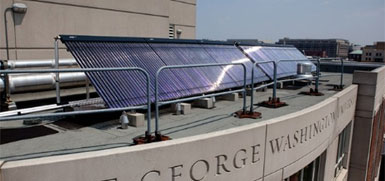by Rona Fried
Following the trend toward sustainability at universities, George Washington and American announced they will source more than half their power from renewable energy.
They’ll be getting it from the biggest solar farm east of the Mississippi River – the Capital Partners Solar Project in North Carolina.
Under construction by the now infamous Duke Energy (its Renewables division), the three adjacent solar farms will produce 52 megawatts for the two universities and also for George
Washington University Hospital.
When it comes online next year, it will provide fully half of both universities’ electricity and a third of the hospital’s – enough power for 8200 homes a year – while replacing the dirty coal-based energy they currently rely on.
And as we’ve seen so frequently lately, the price under the 20-year power purchase agreement is lower than what they currently pay to get electricity from coal.

Like other potential big purchasers of renewable energy, the universities have been scouting for the ability to buy in bulk for years. Until recently, there’s been no way to do that other than developing their own solar or wind farm, but now they get it directly from the grid.
"These kinds of long-term contracts from good-credit buyers can really be helpful to renewable energy developers in getting the financing they need to get projects built. It also allows buyers to get more value out of renewable energy," Neil Kerwin, President of American University, told Associated Press. By joining together, the two universities got a much better price than they would have alone.
American University’s goal is to be carbon-neutral by 2020 and usually appears in the top 10 of the "greenest" college ratings.
Google got the ball rolling with Duke Energy, when it decided to expand its North Carolina data center. Rather than building its own solar plant, it pressured Duke to sell them the power, encouraging the utility to build more solar plants.
Read our article, Big Corporations to Utilities: Please Make It Easy to Buy Renewable Energy.
Now, For Duke Energy
While Duke Renewable Energy moves ahead with new solar farms, the other side of the company is working to kill North Carolina’s Renewable Portfolio Standard!
And the company announced that it’s finished cleanup of the third largest coal ash spill in US history. You no doubt remember that a leaking pipe at an outdated storage pond spewed toxics into the river for days until they finally plugged it. The arsenic, mercury and other heavy metals spread 70 miles down-river.
All cleaned up after just two months! EPA concurs.
But it’s hard to believe that out of about 50,000 tons spilled that removing 2,500 tons qualifies as being done. Water testing shows that water quality is back to pre-spill levels, says Duke.
"This arrogant announcement from Duke Energy is the ultimate insult to the people North Carolina and Virginia whose river has been devastated by the company’s toxic ash spill," fires back Pete Harrison, an attorney for the Waterkeeper Alliance.
"Worse yet, Duke doesn’t even acknowledge the fact that there’s still a public health advisory declaring the river is not safe to fish and swim in. Duke’s celebratory announcement that it ‘completed’ the clean-up threatens to mislead the public into think the danger has passed."
In related news, the other chemical spill that occurred around the same time – dumping chemicals from coal processing into a West Virginia River – happened because of lack of oversight and damaged tanks. In other words, it could easily have been avoided.
There are many more chemical accidents than we hear about. In 2012, 206 million pounds of toxic chemicals – many linked to cancer – ended up in waterways, according to Environment America’s "Wasting Our Waterways" report. Tyson Foods is responsible for about 9% of it. Other "leaders" are Cargill,
Red states – where regulation and enforcement is slim – get most of it: Georgia, South Carolina, Indiana, and Kentucky.
Here’s the report: Wasting Our Waterways: Toxic Industrial Pollution and Restoring the Promise of the Clean Water Act:
Promise of the Clean Water Act
